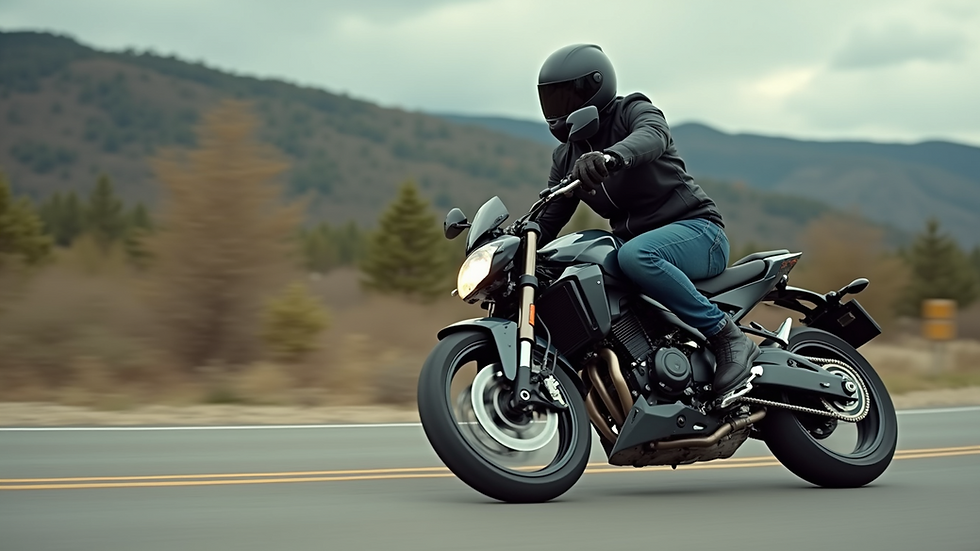Beginner's Guide to Motorcycle Training
- NMR

- Sep 19
- 3 min read
Starting your journey on a motorcycle is exciting. But it can also feel a bit overwhelming. You want to ride safely and confidently. That’s why learning the basics is so important. This guide will walk you through key points to get you started right. You’ll find practical advice, safety tips, and helpful rules to keep in mind. Ready? Let’s dive in!
Why Motorcycle Safety Tips Matter
Riding a motorcycle is fun, but it comes with risks. Unlike cars, motorcycles offer less protection. That means you need to be extra careful. Following motorcycle safety tips can save your life. Here are some basics to remember:
Always wear a helmet. It’s the single most effective way to protect your head.
Use protective gear like gloves, jackets, and boots.
Stay visible. Wear bright colors and use your lights.
Never ride under the influence of alcohol or drugs.
Keep your bike in good condition. Check tires, brakes, and lights regularly.
By following these tips, you reduce your chances of accidents. You also build good habits that make riding more enjoyable.

Getting Started with Motorcycle Training
Before hitting the road, invest time in proper motorcycle training. Training teaches you how to handle your bike safely. It covers everything from basic controls to emergency maneuvers. Here’s what you can expect:
Classroom Instruction - Learn the rules of the road and safety principles.
Practical Riding - Practice starting, stopping, turning, and shifting gears.
Safety Drills - Master braking, swerving, and obstacle avoidance.
On-Road Experience - Ride in real traffic under supervision.
Training builds your confidence and skills. It also helps you understand your bike better. Many states require a training course to get a motorcycle license. Even if it’s not mandatory, it’s a smart choice.

What is the 4 Second Rule for Motorcycles?
The 4 second rule is a simple way to keep a safe distance from the vehicle ahead. Unlike cars, motorcycles need more space to stop safely. Here’s how it works:
Pick a fixed point on the road, like a sign or tree.
When the vehicle in front passes that point, start counting seconds.
You should reach the same point no sooner than 4 seconds later.
This rule gives you enough time to react if the vehicle ahead suddenly stops. It also helps you avoid tailgating, which is dangerous on two wheels. Remember, road conditions like rain or gravel mean you should increase this distance.
Using the 4 second rule keeps you safer and more in control. It’s a simple habit that makes a big difference.

Essential Tips for Your First Ride
Your first ride can be nerve-wracking. Here are some tips to make it smoother:
Start Small - Choose quiet streets or parking lots to practice.
Check Your Gear - Make sure your helmet fits well and your clothes protect you.
Ride at a Comfortable Speed - Don’t rush. Go slow until you feel confident.
Use Both Brakes - Front and rear brakes work together for safe stopping.
Look Where You Want to Go - Your bike follows your eyes, so focus ahead.
Stay Relaxed - Tension makes handling harder. Breathe and stay calm.
Practice often. The more you ride, the better you get. Don’t be afraid to take breaks and review what you’ve learned.
Maintaining Your Motorcycle for Safety
A well-maintained bike is a safe bike. Regular checks prevent breakdowns and accidents. Here’s a quick maintenance checklist:
Tires - Check pressure and tread depth.
Brakes - Test responsiveness and look for wear.
Lights - Ensure headlights, brake lights, and signals work.
Oil and Fluids - Keep levels topped up and change oil as recommended.
Chain and Cables - Lubricate and adjust for smooth operation.
Keep a maintenance log to track what you’ve done. If you’re unsure, visit a trusted mechanic. Taking care of your motorcycle protects you on every ride.
Starting your motorcycle journey is thrilling. With the right training and safety habits, you’ll enjoy every mile. Remember to invest in quality gear, practice regularly, and respect the road. If you want to learn more or find training near you, check out motorcycle training. Ride smart, stay safe, and have fun out there!





.png)



Comments